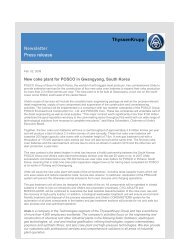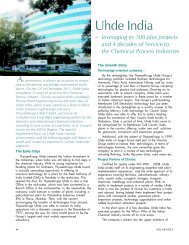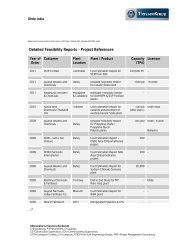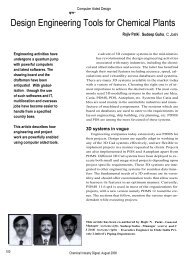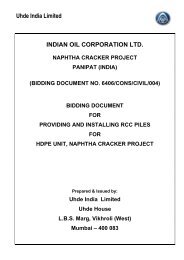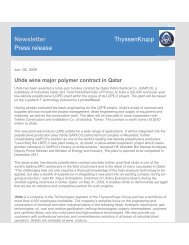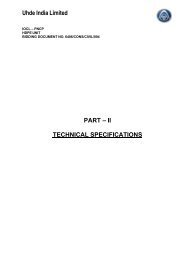Cryogenic storage of Ammonia.pmd - Uhde India Limited
Cryogenic storage of Ammonia.pmd - Uhde India Limited
Cryogenic storage of Ammonia.pmd - Uhde India Limited
Create successful ePaper yourself
Turn your PDF publications into a flip-book with our unique Google optimized e-Paper software.
<strong>Cryogenic</strong> is a Greek word meaning “the production<strong>of</strong> freezing cold,” however, the term is usedtoday as a synonym for the low temperature state.It is not well defined at what point on the temperaturescale refrigeration ends and cryogenic begins.There are number <strong>of</strong> gases that require cryogenic <strong>storage</strong>se.g. ammonia, chlorine, LPG, propane, propylene,ethane, ethylene, natural gas, oxygen, nitrogen, hydrogenetc.In this article we have described about the differenttypes <strong>of</strong> ammonia <strong>storage</strong>s methods, typical configuration<strong>of</strong> <strong>storage</strong> systems, various codes and standards, designguidelines, guarantees involved, commissioning &recommissioning procedures, hazardous area classification,safety aspects, ammonia transportation challengesand opportunities for cryogenic <strong>storage</strong>s.Types <strong>of</strong> ammonia <strong>storage</strong> tanksLiquid ammonia is usually stored either at ambienttemperature under high pressure or at -33 o C under atmosphericpressure. In some cases, it is also stored at intermediatetemperatures and pressures (semi-refrigerated).❖❖❖Pressurised <strong>storage</strong> (pressure: 12 – 18 kg/cm 2 g) atambient temperature for small capacities (up to 100MT) is in horizontal pressure vessels.Semi-refrigerated <strong>storage</strong>is in spheres for capacitiesup to 2000 MT(pressure 4 – 6 kg/cm 2g).Atmospheric pressure<strong>storage</strong> is at -33 o C forlarge capacities (2000MT and higher). Thereare three differenttypes <strong>of</strong> tanks for suchCarbonsteelcontainerInsulation<strong>Cryogenic</strong> Storage<strong>Ammonia</strong>dischargelineConcretefoundationFig A1. Single wall with external insulationcryogenic <strong>storage</strong>, viz:A) Single Wall TankB) Double Wall TankC) Double Integrity Cup-In TankLet us review each one separately.A) Single wall tankThese are the tanks with one steel bottom and walldesigned to contain the full liquid level <strong>of</strong> ammonia. Insulationis provided on the external surface to minimizeheat leakage Fig A1. External containment is provided inthe form <strong>of</strong> dyke wall to contain the liquid coming outdue to rupture <strong>of</strong> inner tank. From Health, Safety and Environmentperspective single wall tanks are not recommendedand hence these are no longer built. ExistingSingle wall tanks are being replaced with Double IntegrityCup-In Tanks. See Fig A2.B) Double wall tankThe outer tank is intended to contain refrigerated productleakage from inner tank but is not intended to containany vapor resulting from product leakage from theinner tank which means, it will be released to atmospherethrough flare. See Fig B1 and Fig B2. The outer containeris normally provided in the form <strong>of</strong> “Bund wall” <strong>of</strong> heightCarbonsteelcontainerInsulationFig 1. Single wall tanksConcrete for carbonsteel weatherprotection<strong>Ammonia</strong>discharge lineConcretefoundationFig A2. Single wall with external wallCarbonsteelinner tankInsulationCarbon steelouter tank<strong>Ammonia</strong>discharge lineCarbonsteelinner tankInsulationCarbon steelouter tank<strong>Ammonia</strong>discharge lineConcretefoundationConcretefoundationFig B1. Double wall TankFig B2. Double wall tank with common ro<strong>of</strong>Fig 2. Double wall tanksChemical Industry Digest. October 201277CMYK



